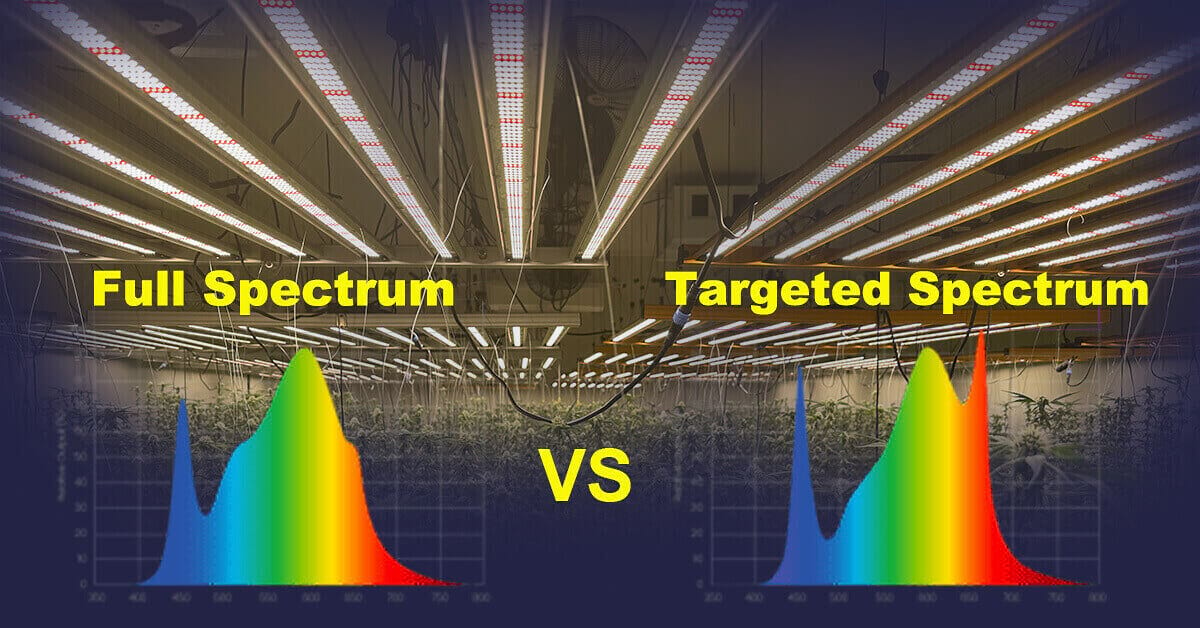
Full Spectrum vs Targeted Spectrum Grow Lights: Tailoring Light for Better Yields
Introduction
Indoor farming has revolutionized how we grow plants, but one critical question remains: should growers employ full spectrum or rather target spectrum grow light services to maximum their yields? In light of the changes that are taking place in the current agriculture, it is important to learn about the advantages of each of the lights to improve crop yields. This article compares and contrasts full spectrum with targeted spectrum grow lights and makes recommendations on light conditions to enable efficiency and good plant growth.
What Are Full Spectrum Grow Lights?
How Full Spectrum Lights Benefit Plant Growth
Spectrum grow lights are light bulbs that will cover light spectrum from ultraviolet (UV) through infrared (IR). Due to such a broad spectrum of light, they are useful and applicable in different plants and of different growth levels. For instance, make certain that if you are growing lettuce, tomatoes or flowers, full spectrum lights are useful during seedling, and vegetative, and flowering phases. Even though green and yellow wavelengths are not associated with the photo synthetic process they are useful in modifying the overall plant health and penetration of light to all parts of the canopy of the plant.
He further used real life example or growing light that pointed to the fact that full spectrum light offered 15% more robust growth on plants than those being grown under targeted spectrum hence the efficiency of full spectrum across the plant kingdom.
Blue and Red Light: Key Roles in Plant Growth Stages
In the context of the full spectrum, there is specialization of the blue and red light components as far as the development of plants is concerned. Vegetation light, light ranging from 400-500 nanometers, is very important for the growth of plants by enhancing the stem and leaf size of the plant. On the other hand, red light (600-700 nm) is helpful for flowering and fruiting by promoting bud formation and flowering in crops such as tomatoes or marijuana.
The combination of these two wavelengths make full spectrum lights to be able to support plant growth during different stages with less change in lighting. For example, an indoor cannabis farmer discovered that lighting his plants with full spectrum lights all through to the flowering stage meant that he received a 20 percent increase in the yield of his plant because of the blue light that has a positive effect on the vegetative growth of the plant and the red light which hastens flower formation.
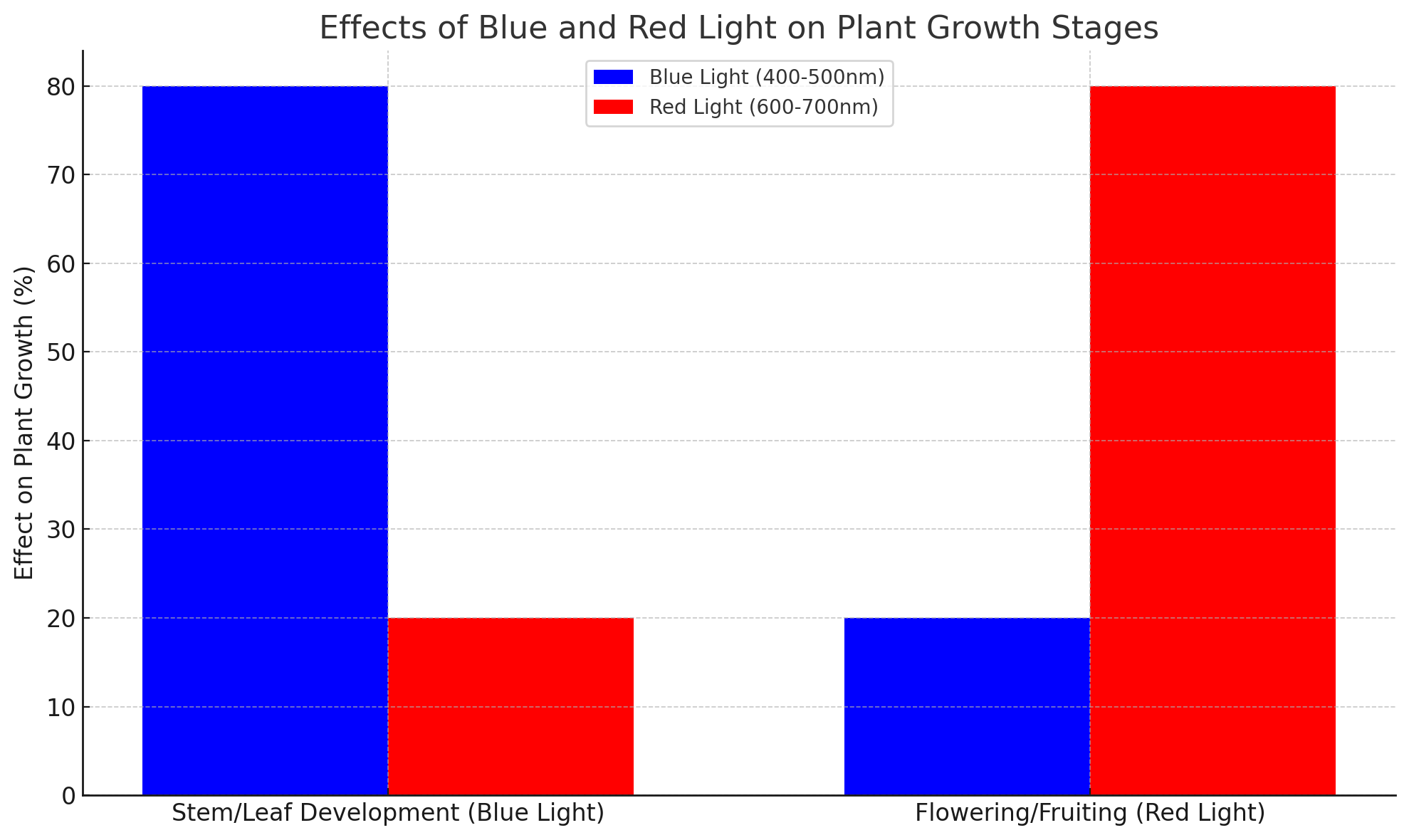
PAR Values and Full Spectrum Efficiency
Photosynthetically Active Radiation (PAR) is defined by the range of light wavelengths which are between 400 and 700 nm the plants can use to carry out photosynthesis. This makes full spectrum lights generally possess high PAR values making the light source efficient for offering light that goes through various parts of the plant.
PAR values should be as high as possible to help the plants absorb as much light as they can. For instance, an experiment that involved full spectrum and targeted spectrum grow lights showed that PAR of full spectrum light enhanced by 25% in penetration consequently increasing growth yields especially on crops that are closely knit such as lettuce and spinach.
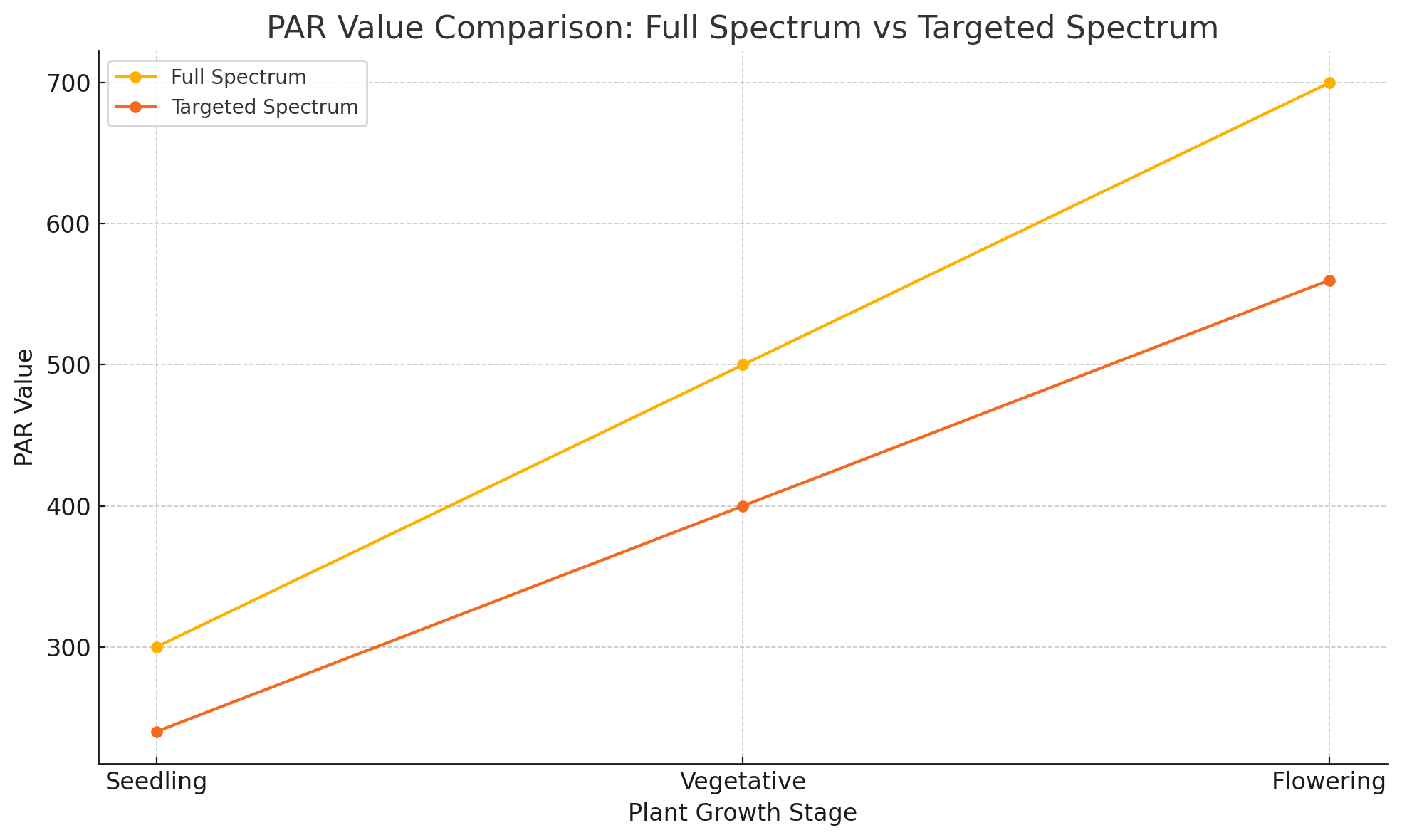
What Are Targeted Spectrum Grow Lights?
The Role of Blue and Red Light in Targeted Spectrum Efficiency
Targeted spectrum grow lights are designed to emit these exact wavelengths which are necessary for the photosynthesis process most notably blue and red light. Unlike full spectrum light that provides a combination of wavelengths, targeted spectrum light provides the necessary light which is required the different stages of plant development. This focus on blue and red wavelengths increases the energy efficiency dramatically by getting rid of light which is not utilised as efficiently by the plants such as green and yellow light.
Radiation of blue spectrum the range of which includes 400-500 nm is required during the period of vegetative development as it helps the plants build strong root system and build up the foliage. For example, targeted spectrum lighting with a relative emphasis of blue light is utilized in the first stages of the life cycle of leafy greens or herbs, for compact growth. On the other hand, red light (600-700 nm) is very important to the plant when it is flowering or fruiting to enhance the formation of buds and increase yield in all crops including tomatoes, pepper or marijuana.
One of the real life example here is the indoor tomato growers who employed the use of targeted spectrum lights in the ratio of 3:1 red to blue during the flowering stage. With the targeted light they established that they received 30% more fruits compared to plants grown under full spectrum light hence underlining the importance of using grow light for maximum output during especial phases.
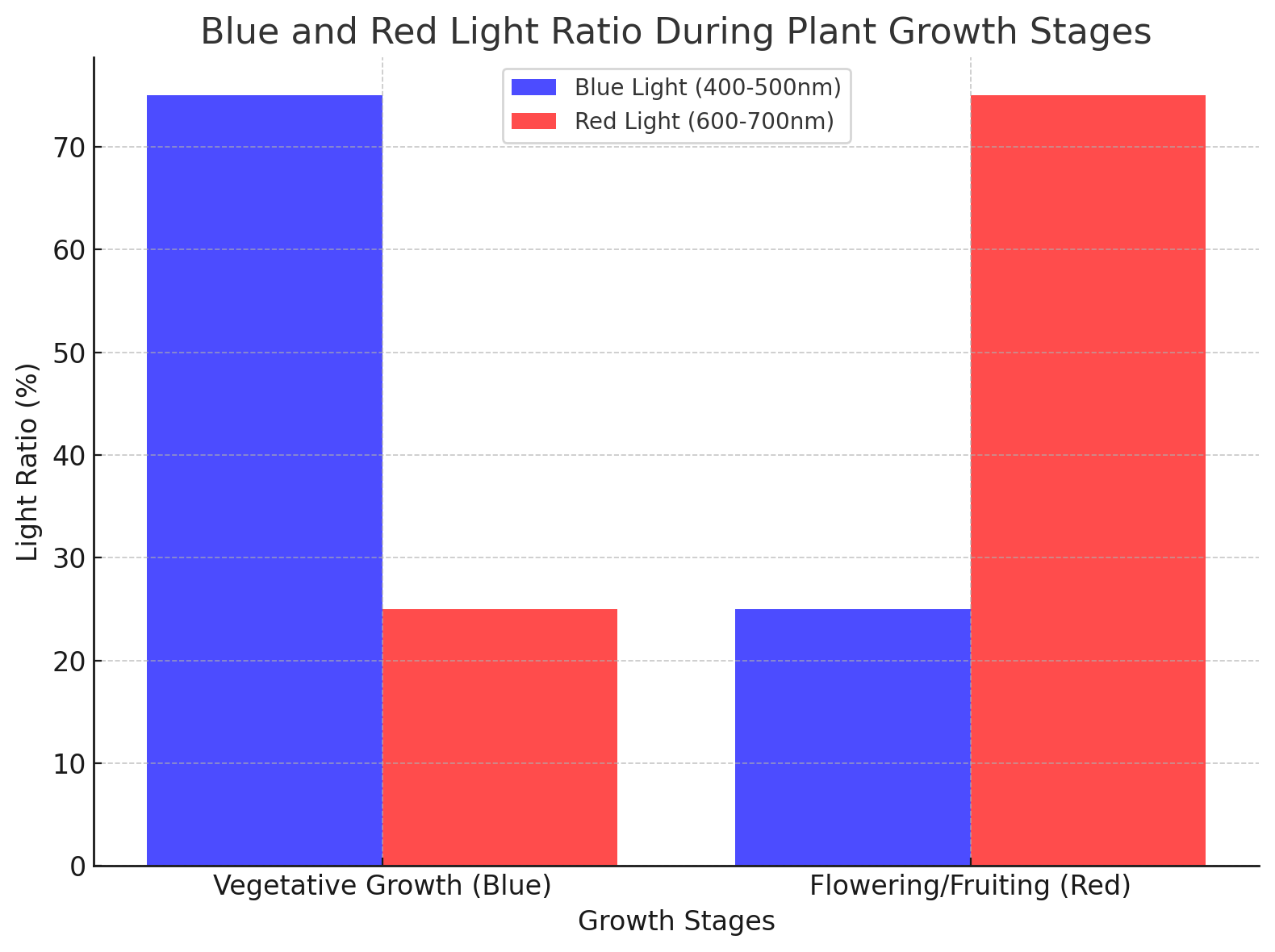
Tailoring Targeted Spectrum for Maximum Yield
Targeted spectrum grow lights can be considered highly advantageous mostly due to their versatility. The intensity and quality of light can be regulated in order to add a overall positive outcome to theplant health and crop yield of different crops and any stage of growth. It has also been proposed that, by utilising programmable or adjustable spectrum LED lights and so achieving optimum spectrum specifications, the light can be fine tuned for enhanced growth and production.
For instance, the crops like the spinach, lettuce and others that are shrubby in nature require a higher ratio of blue light while on the other side crops like strawberries and some varieties of cannabis need a higher ration of red light during the flowering period. Another experiment made on the strawberry plants revealed that when the red light component was increased during the flowering stage the yield was 25 percent higher than that in the full spectrum.
In addition to improving plant production, the light condition settings are unique and friendly on power consumption. Owing to reducing electricity and cooling cost by using only required wavelengths, the targeted spectrum lights are perfect for home growers, as well as commercial growers. It also helps to create crops of a better quality that include better structure in plants, high THC in marijuana or even better color in the flowers.
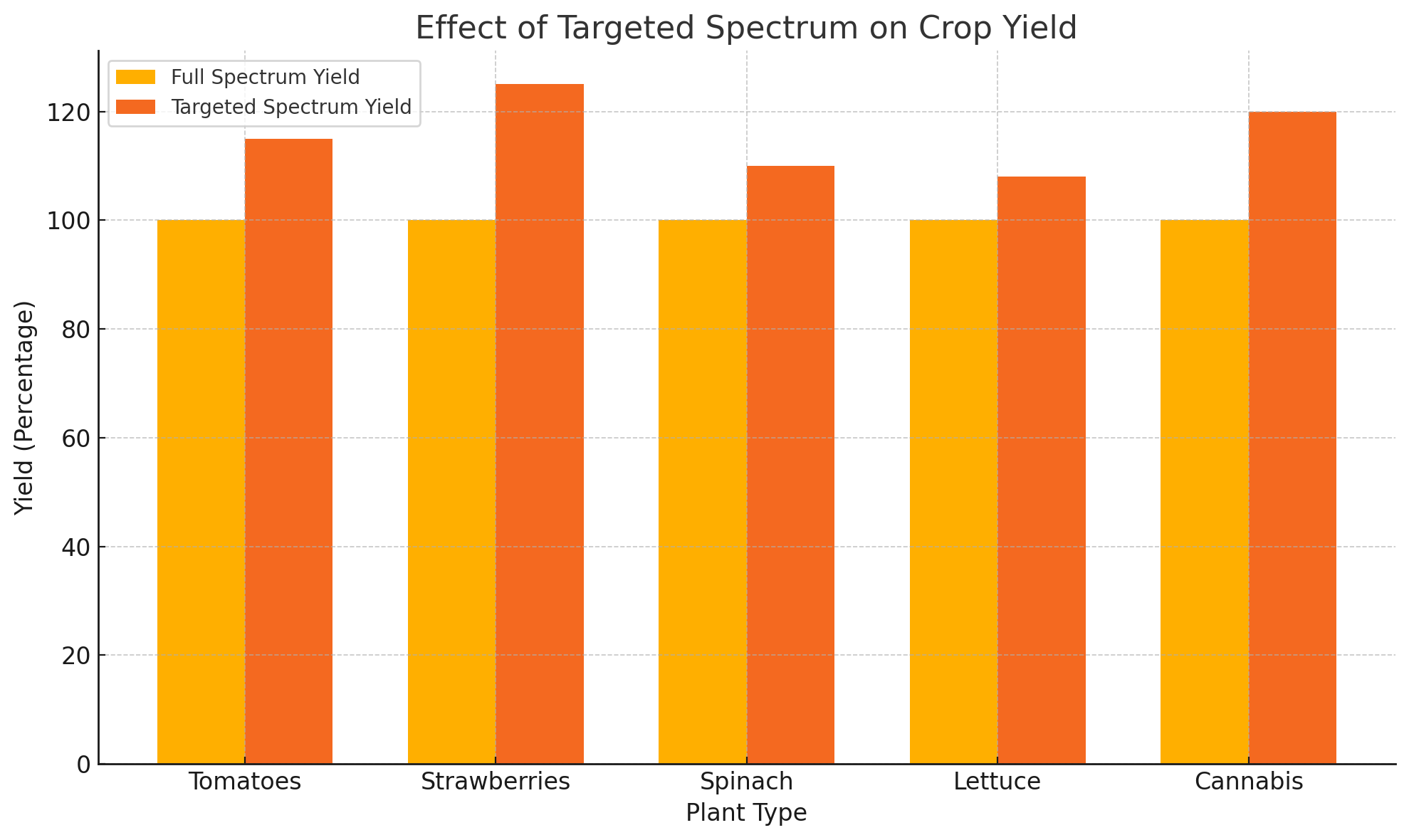
Customizable Spectrum Solutions for Different Crops
Tailoring Blue and Red Light for Optimal Crop Yield
Every kind of crop has or reacts differently to specific lighting spectrums especially with regards to the blue and the red elements. These plants also create the diversification of these wavelengths, and alterations can be made so that the grower can optimize the crops nominal yield and quality of growth.
For instance, tomatoes require ratio of red light during the period of plant flowering and fruiting to facilitate improved formation of flowers and bigger and better fruits produced on the plant. When the plant is grown and the phase that is beneficial for flowering and fruit creation is concerned, it has been seen that the light spectrum that is effective for the red light can cause an enhancement in fruit yield up to 20 per cent when compared to tomato cultivation in normal condition. On the other hand, during the vegetative stage, when there is introduction of more of blue light, the plants produced have denser foliage and stronger roots which are very critical for the health of the plant.
For the kinds of crops such as lettuce and spinach that are more developed on the vegetative stage, more blue light is required throughout the duration of the growth process. Blue light increases the density and compactness of leaves: the quality and marketability of the final product are therefore improved. A brief controlled experimental investigation carried out by the researcher revealed that lettuce grown under light that favoured the blue end of the spectrum displayed 30% denser canopy size and had more magnificent green pigmentation than lettuce grown under full spectral light.
Roses and chrysanthemums are examples of plants whose canopy light quality provides a good balance for plants vegetative growth and flowering. During the bloom phase, growers are able to control the intensity of the red light in order to bring out the more vibrant and larger flowers while blue light helps to strengthen the stalks and leaves of the plant. When it comes to ornamental gardening especially where the size and intensity of the colors matter expect this to be done appropriately on the flower spectrum.
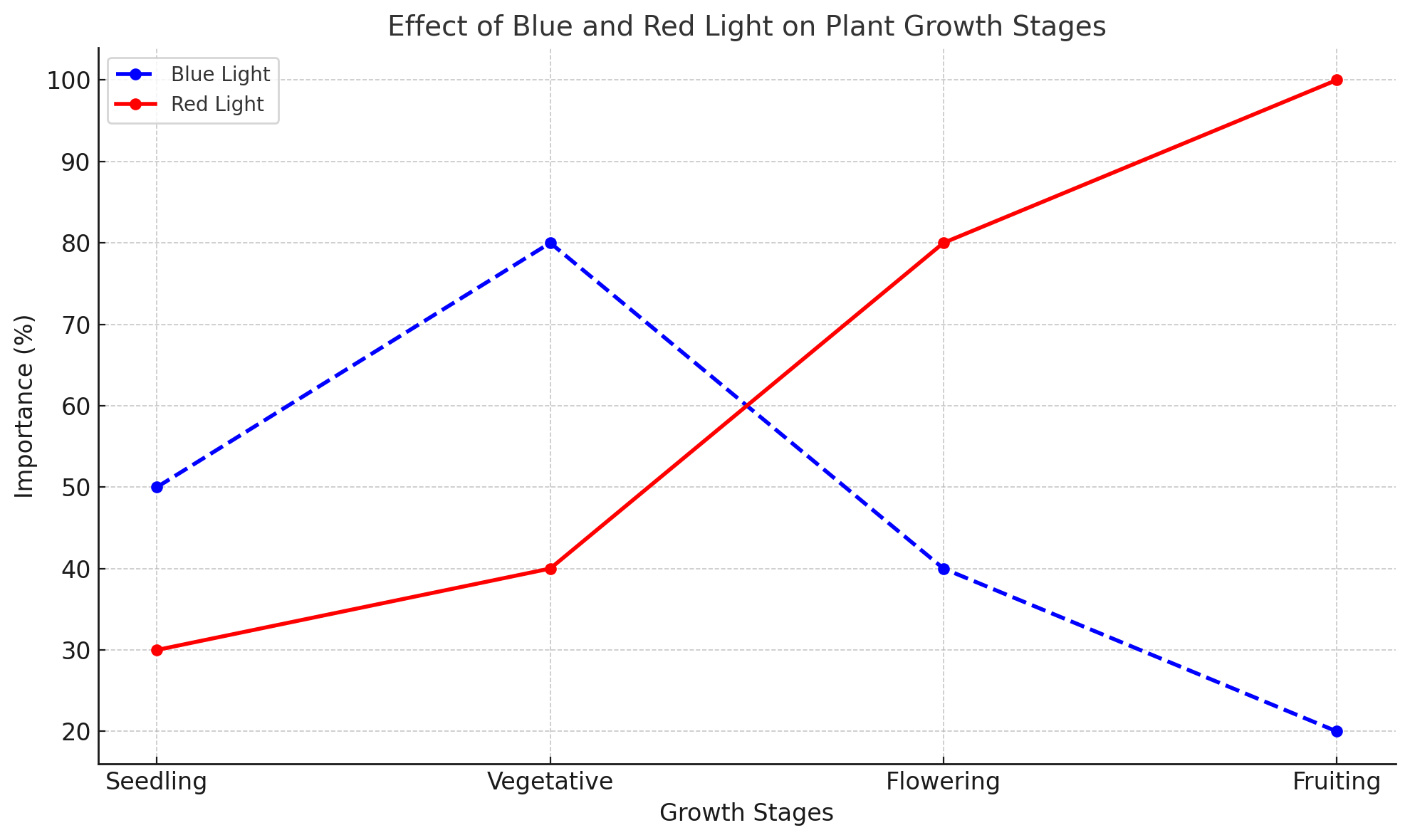
Using Blue and Red Light to Enhance Stress Resistance in Crops
Apart from increasing yield, growers can also use techniques of regulating the blue and red light exposure to enhance plant responses to what may be considered as stress factors like high heat, low rainfall or a pest attack. Scientific evidence prove that it is possible to harden plants to difficult growing conditions by controlling the light spectrum, and as an effect, plants would thus exhibit better conditions of health.
From previous studies, it was determined that blue light helps a plant to build up more photoprotective compounds and to regulate the water content in the leaves and to develop thicker leaves. For instance, Horta to appareled change the intensity of blue light usually used on crops such as spinach or basil subjects the productions to Drought stress and yet the plants yield is improved by 15% water use efficiency under limited water conditions.
On the other hand, red light assist plants to develop better root structures and enhance their capacity to handle diseases and pest infections and nutrient poor soils. There is also enhanced pest resistance since increasing the red light’s intensity to germinating cucumbers enhances pest resistance since the plants will grow healthy thus reducing their vulnerability to pest attacks.
Stress hardening by manipulating the light spectrum is environmentally friendly, and non-GMO unlike most chemical inducers that are currently being used in the process, which makes the method preferable, especially for farmers, who seek sustainable methods of plant improvement.
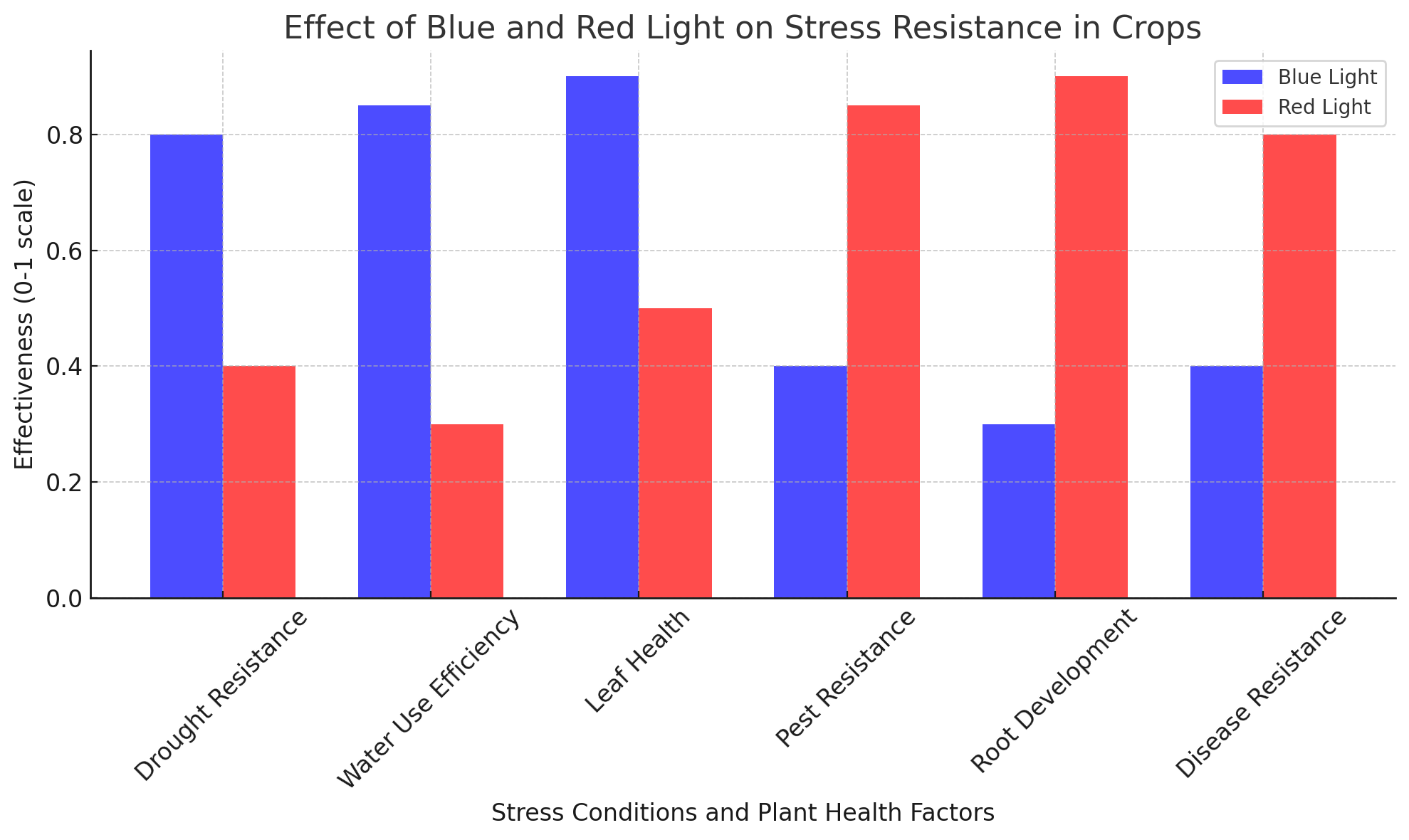
Meeting Specific Needs of Different Plant Types with Targeted Spectrum
Every plant is known to have certain light demands depending on the kind of growth habits that it possesses and this aspect is well handled under the targeted spectrum lighting conditions. By adjusting the spectrum according to different plant types, the growers make the optimum environment that enhances the quality and quantity of the yield.
For example, cannabis plants have to be switched from one light spectrums to the other during the vegetative stage and the flowering stage. In the vegetative stage a higher blue light provides compact and bushy structure, whereas changing to red promoting floral initiation and THC synthesis in the flowering phase. Research has also displayed that modification of the red light in the flowering phase is effective for a raise in THC levels by up to 20%.
Likewise, foliar-promoting plants such as basil and cilantro require steady blue light throughout their development cycle for proper leaf development. Some plants like the peppers and strawberries, on the other hand, require a red dominant spectrum during the flowering period in order to enhance the fruiting process. Since the intensity of light depends on wavelengths, the grower will be able to control the precise kind of light that is required by each plant at a certain stage in its life cycle so as to achieve the maximum production possible from the crop.
Full Spectrum vs Targeted Spectrum: Pros and Cons
Energy Efficiency Comparison: Full Spectrum vs Targeted Spectrum
When it comes to energy efficiency, growers can expect either very considerable differences depending on the type of the given grow light source between full spectrum and targeted spectrum grow lights. First, full spectrum lights do deliver wavelengths across a broad range, however, they actually emit some lights that are not efficiently used by plants especially green and yellow light. Some of these wavelengths are not useful for photosynthesis and still need energy to be generated hence high energy use. However, full spectrum lights may be less energy saving and this could mainly be attributed to the fact that the plants grown are under controlled conditions that do not require the full range of natural light.
On the other hand, target spectrum lights illuminate only those colours that are helpful to the plants, for instance blue or red light which are crucial in vegetative growth and flowering respectively. Targeted spectrum lights also help to minimize unnecessary waste which is evident through the removal of spectral components outside its operation range. This leads to a more undisturbed way to deliver the right kind of light they require to their plants making them conservative in their energy usage as well as light. For instance, research has indicated that when people change from full spectrum to target spectrum light they can be able to save up to 30% on energy costs, while at the same time the plants’ growth and production rates increase or remain at par with those under full spectrum light.
These improvements in efficiency are especially well for growers who want to decrease the amount of electricity that they used and the amount of harm that they are doing to the environment. With the help of targeted spectrum lights they are able to achieve high productivity without having to overuse energy-doling full spectrum lights.
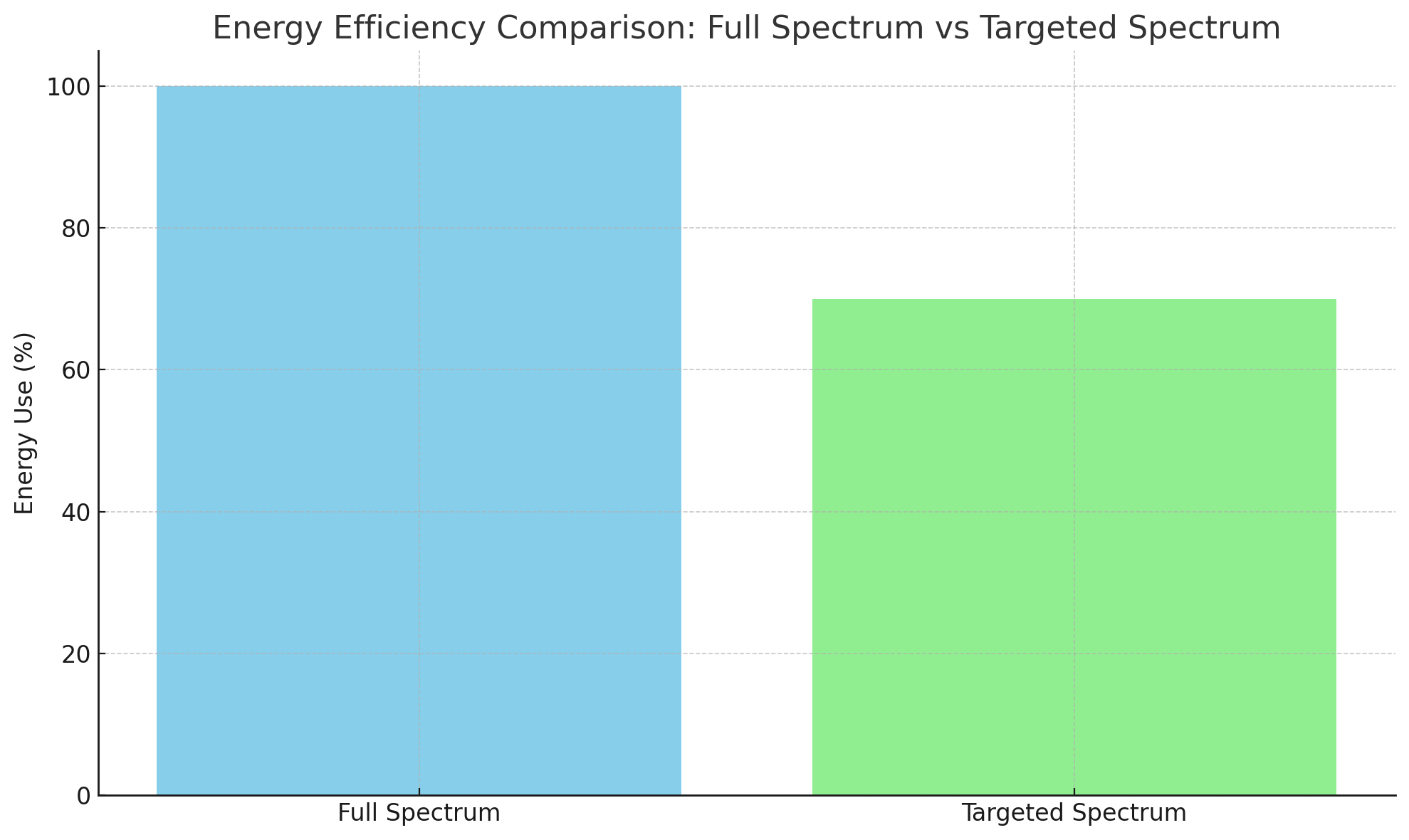
How Targeted Spectrum Reduces Energy Use in Large-Scale Farming
Lighting can cost a lot of energy particularly where the growing is done indoors in large scale production.” Outdoor grow spectrum light solves this challenge by greatly reducing wastage of energy used in lighting while delivering the necessary amount of light required in plant growth.
For instance, in large-scale vertical farming which is indoor farming involving crop production such as lettuce, tomatoes, and cannabis, or even any plants, it is possible to have the targeted spectrum light only blue light during the vegetative growth stage and red light during the flowering stage. This means that the lights are only performing the minimum requirement of providing energy that is required for the plants growth and development and excluding the batch of energy that is unwanted.
According to the vertical farm with a large area in California, making a change of using full spectrum light to targeted spectrum LED grow lights, they realized that the energy consumption was reduced by twenty five percent. what they were able for each growth stage is to use the favorable light spectrum in order to achieve high yields of production while minimizing the total amount of energy required or consumed in the process of running the facility. This also meant a direct cut in cooling costs, as targeted spectrum lights are generally less inclined to produce more heat as compared to full spectrum lighting.
Another case is a commercial producer of Cannabis in Colorado: They were able to cut their energy expenses on lighting by around 40% after switching to targeted spectrum lights and all this while boosting the quality of harvest and its yield. When applying specific light spectrum that correspond with the specific demands of the plant growth, the grower was able to eliminate some of the costs, which in addition fixed the productivity cycle of the production.
It is therefore easy to see why targeted spectrum lighting is very efficient in large-scale farming since it is designed to light output for certain crops during specific growth stages. Through achieving lower energy requirements, these lights have a positive impact to the income as well as the environment hence being adopted by most commercial growers as they seek to enhance their operations.
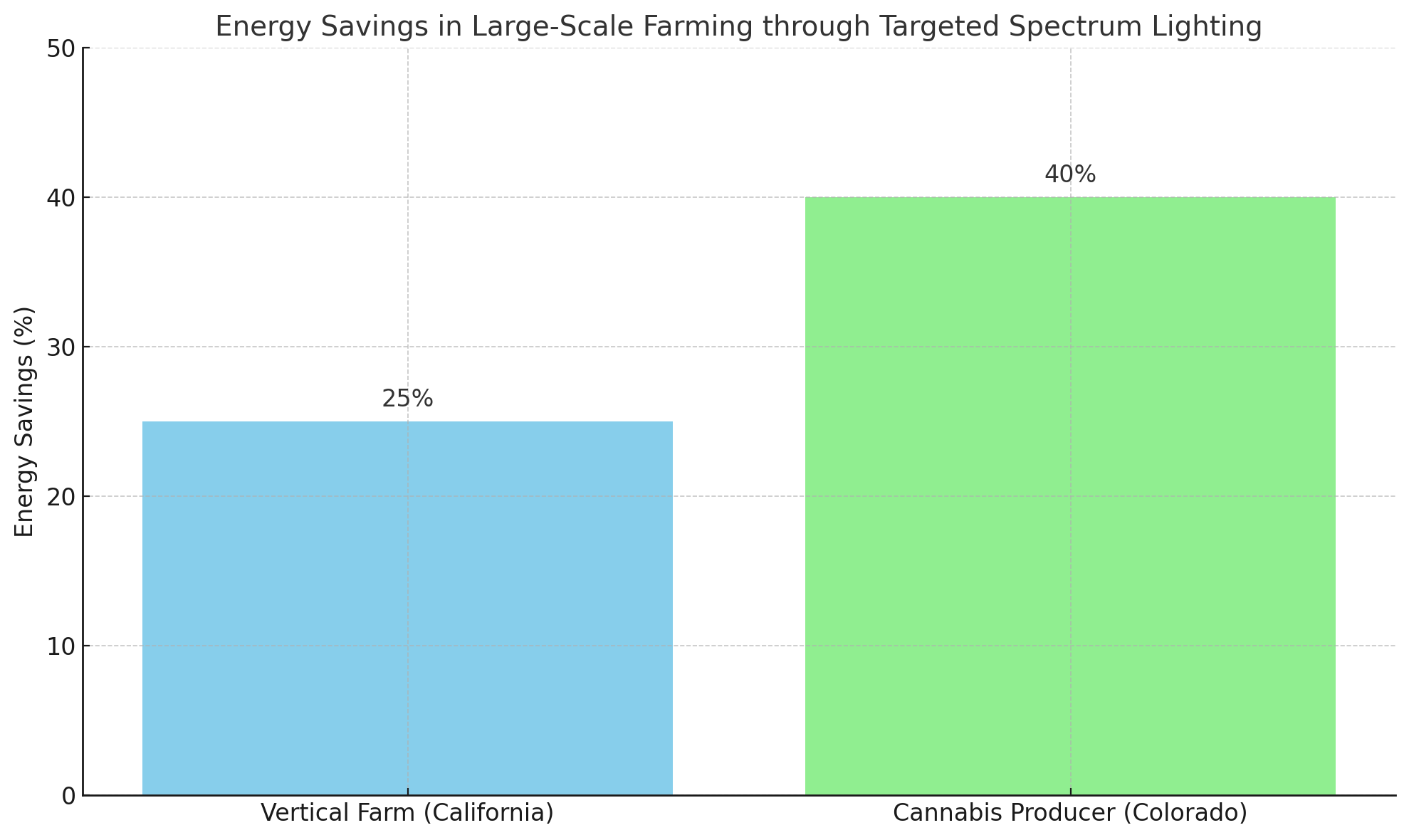
How to Choose the Right LED Grow Light for Your Plants
Light Requirements for Seedling, Vegetative, and Flowering Stages
It is critical when choosing LED grow light that one understands the different light needs to grow at various phases of the plant growth cycle. Crop plants often require different nutrients and in different proportions in different developmental phases and therefore, the need to feed them with these nutrients appropriately if we expect to get the best yields.
1.Seedling Stage: Seedling stage plants are small and tender and for their growth, they need low amount of light which belongs to blue light spectrum (400-500 nm). Enhances root development, compact growth, and sets a good tone for the plant to grow from the base, hence an ideal light for the plant. For this stage using LED with low wattage and more reen focusing on blue light will help seedlings to grow strong and not to become ‘leggy’.
- Example: For basil seedlings grown indoors, the light that growers should use should have around 20-30 PAR values and with a bias to the blue spectrum for effective early-stage growth of seedlings.
2.Vegetative Stage:During the vegetative development phase plants are much more demanding in terms of light, as the new leaf, stem and root biomass must be generated. Blue light remains to be effective but higher values of light intensity are required for enhancing vigorous growth of the vegetation. At this phase, high PAR LED lights together with higher blue spectrum light between 60-80% boosts the strength and vigour of the plants.
- Example: provides lettuce growing the 18-24 hours of Blue Light which ranges at around 300-500 PAR leading to production of thick and well nourished leaves.
3.Flowering Stage: The flowering stage is when plants direct more energy on formation of flowers or fruits hence need more of the red light (600-700 nm). Red light helps in the evoking of buds and aids the plant in fruiting process. The best lights for this phase include LED grow lights, which have more of red light and have a PAR range of 500-700.
- Example: Percentage of Red light (PAR) for flowering is used at higher settings during the flower stage and growers tend to raise the intensity of the red light growing buds larger and promoting more resin production thus having PAR values over seven hundred for the best flowering outcome.
It is because of these light requirement differences that growers can now choose the right LED light for each stage given that plants only require the right wavelengths and appropriate light intensity for growth and bountiful production.
Adjustable Spectrum Lights for Versatility
As a result, adjustable spectrum LED grow lights are the best option for growers who want to achieve complete flexibility and versatility of operations. These lights give the users the ability to change the intensity of each hue to suit the plant at its growth phase, without having to buy different Systems, or always changing the bulb.
This kind of spectrum light can be programmed with and allows growers to change the blue:red light balance. This feature is rather helpful when cultivating numerous plant types or tending for crops that require different amounts of light during different stages of development. For instance, a grower who has both, leafy greens and flower producing plants such as tomatoes can use adjustable spectrums to provide blue light during growth of the greens and shift to red light during the flowering times of the tomatoes.
Further, those lights are useful as the intensity can be changed to vary light spectrums to enhance plant health. It can be adjusted by growers according to their preference for the much-needed varying intensity of blue to red spectrum for specific kinds of crops. At the same time, this allows not only a better stimulation of the plant growth, but also reduces energy consumption because the amount of light can be adjusted according to the plants requirements at a specific time.
Thus, the adjustable spectrum light is an excellent solution for trade organizations as it does not require purchasing various specific lighting equipment. This flexibility allows the growers to expand their operations and at the same time control the necessary lighting for the plants ranging of the growing process from seedling stage, vegetative growth stage, the flowering stage, up to the ripening or the harvesting stage.
Balancing Cost and Efficiency in LED Grow Lights
Tips for Choosing the Most Cost-effective LED Grow Light
Selecting the right LED grow light is not about just getting a light that would be cheap but amounts to investing in a light that wouldn’t be expensive while at the same time delivering the light that your plants require for optimal yield. Here are some tips to help budget-conscious growers make smart purchasing decisions while ensuring optimal plant growth:Here are some tips to help budget-conscious growers make smart purchasing decisions while ensuring optimal plant growth:
1.Focus on PAR Efficiency:It is the measure of the light with the ability to promote photosynthesis in plants and is used to determine how well a grow light transmits usable light. When considering LED lights consider those that have high PAR output per watt of energy consumed because these provide better plant growth. A specific light, perhaps one with a high PAR value may initially be more expensive to purchase but in the long run one is able to recover their investment by having better yield and less energy consumption.
2.Evaluate Lifespan and Durability:However, you will learn that even though cheaper models may seem more cost effective in the short run, they will, for instance, have shorter durability, meaning that they might end up being replaced more often. When comparing between LED light and other forms of lighting it is therefore important to look at the duration of the LED light. There exists higher quality of light emitting diodes, which generally lasts longer (up to 50000 hours) which is more economical in the long run. Opt for grow lights that come with warrantee’s as this will show the durability of the lamps.
3.Consider Energy Consumption:Once again, energy costs can be very expensive, or rather, very costly especially if one is operating a large operation or growing their plants under light for long periods. Choose the LED grow lights that produce high output with energy consumption with a priority on energy efficiency. One can see that the targeted spectrum lights are generally more energy-efficient than full spectrum models as they give out only the necessary wavelengths to promote plant growth.
4.Size and Coverage Area:In choosing an LED light for your grow room, it’s important that you should consider the area of the place where you’ll be placing your plants. While indoor gardens can be small, a single light which has moderate coverage may be enough, if space is much larger then you will need multiple lights. Ensure that the chosen light gives adequate coverage without cases of over lighting that is costly in terms of energy or under lighting that affects the yield. Manufacturers normally give their ideas on recommended uses for the products that they are manufacturing.
5.Modular and Expandable Systems:If the grower is considering expansion in the future then then he or she should consider selecting grow light systems that can be expanded easily. These systems enable you to include additional lights when required instead of using an entirely new system, makes it easier and can be cost effective in the long run.
Thus, by taking these factors into consideration growers get to purchase a cost-efficient LED grow light that provides for their plant’s health and due yields without overextending on the expense.
Budget-friendly vs Premium Options
When selecting LED grow lights, there are generally two categories to choose from: In particular, you are going to examine the following conceptual categories: ↵
cost-effective variants and luxury models. All of them have their pros and cons and knowledge of these will enable the growers to make the right decision depending on the type of light they want and depending on the kind of money they are willing to spend.
1.Budget-friendly Options:Low cost LED grow lights are suitable for the novices or those who require limited lighting because they are cheap to acquire. These light usually has low wattage and PAR which might not be able to supply adequate light requirement for some plants but they could be useful for the vegetative stage. Some cost-effective Led plant lightbudget models are full spectrum which means that they cover a wide range of light spectrum without purposing the different development stages of plants.
- Example: A basic 100W Full Spectrum LED grow light could range from $50 to $100 and enough for a small area such as herbs and greens and even small plants. Although it is a viable beginner light, it may not hold enough light for the plants that are meant to flower or bear fruits such as tomatoes or weed.
Pros: Less expensive in the startup, perfect for the small or the less complex crop, easy to establish.
Cons: Lower working lifespan, lower rate of conversion efficiency, and inability to control the specific usage of the spectrum.
2.Premium Options:The premium LED grow lights are recommended for the professional or the commercial growers since they intend to provide high yields and efficiency. These lights can be controlled in terms of their spectra, come with high PAR output and include some new features such as dimming, control mechanisms and in-built cooling systems. Also, premium models are more durable and energy efficient and therefore guarantee better value per year.
- Example: A high-end 600W adjustable spectrum LED grow light could be anything ranging from $600 to $1,200 including the luxury of controlling between the blue and red light spectrums. It enables the growers to focus the light on the growth required for certain part while at the same time optimizing the yield and quality. It also occupies more space, consumes less power per unit of production and thus is well suited for business operations.
Pros: Efficiency, enhancements, Spectrum organization, Longevity.
Cons: This has a higher cost, compared to UG and is more complicated to set up; additional cooling may be needed in large systems.
Choosing Between the Two: Picking between cheap and expensive LED grow lamps can be concluded primarily by the size of the farm and the goals set. As for hobby farmers with very small plots of land and, consequently, relatively simple requirements for crops, it is possible to start with low-cost models. However, for the serious growers who are willing to spend more of their cash in order to make even better and bigger harvest, then there are better ones that offer more options, convenience as well as long term benefits.
The Rise of Customizable Spectrum in Commercial Agriculture
Why Customizable Spectrum is the Future of Indoor Farming
In the commercial agriculture, spectrum grow lights are on the rise as the indoor farming gets more and more advanced. This change is due to the want of higher accuracy of plant growth conditions in order to increase the yields and better the quality of crops as well as increasing energy efficiency. Flexible spectrum lamps, as mentioned, make it possible for growers to adjust the wavelengths plants get in the vicinity hence grew light conditions suitable for each stage or crop type.
HPS lights have been seen to have extraordinary potentiality for large scale production because growers can adjust the light intensity to match the plant requirements at the vegetative or flowering stage. For instance, those crops that need blue light for their vegetative part can be provided with this light in the right quantity while the flowering plants can be exposed to the high red light when the productivity is necessary without wasting energy.
Third, and perhaps the most convincing of all the arguments to supporting the call for customizable spectrum as the future of indoor farming: flexibility is an opportunity to optimize it. The energy inputs by growers can be minimized by removing the unnecessary wavelengths which the plants do not absorption. The light control that is maintained here is very specific in that it adjusts both the energy wasted and the amount of energy that promotes growth, thus enabling the production of bigger yields in the least amount of time and energy. It is clear from this study, conducted in a commercial greenhouse that the use of customizable spectrum grow lights results in an increased by about 25% yield while at the same time has a 30% less energy usage, evidencing the potentials of targeted lighting.
Additionally, the customizable spectrum grow light offer the growers the opportunity to easily adjust in order to meet new conditions. For example, if one crop is experiencing stress then the light spectrum can be changed as it can happen in real-time; if blue for root development is necessary or red for rapid flowering. This is very important especially in large scale operations because the company may have to increase or decrease production at some times.
Market Demand for Customizable Spectrum Solutions
The increase in demand for the spectrum solution that is tailored for its particular use is evident as a result of the increase in the emphasis on the precision agriculture. The use of technology is also seen to be central in achieving better outputs in indoor farming and controlled environment agriculture (CEA) systems that are fast gaining ground across the globe.
From the industry analysis, it can be seen that the sales of LED grow lights is expected to soar to $3. 6 billion by 2025, this is due to the uplift in the use of spectrum lights in commercial farming in a way that can be customized. A lot of this growth is attributed to large scale growers within segments that include horticulture and cannabis cultivation as well as vertical farming since light environment modifications offer an ideal environment for crops to thrive.
Another study that focused on commercial growers revealed that 70% of the growers claimed that energy efficiency coupled with flexibility in the light spectrum was an important reason for adopting new plant lighting systems. A common benefit often stated by a number of growers is the increase of yield, quality and consistency which they attained after opting for customizable spectrum solutions. For instance, vertical farming of lettuce all year round which requires light for photosynthesis is more likely to prefer the customizable option because of versatility of the lights in that it can be programmed to have a certain brightness depending with the crops planted, seasons and weather changes.
As THC and cannabinoids are on high levels of importance in the cannabis industry, such a tool, as the customizable spectrum lights, is becoming increasingly inevitable. A major advantage is that growers are able to increase the red light during flowering which increases the amount of cannabinoids and thus the yield. This versatility to different cycles of cannabis growth is one of the leading factors for the increasing market appetite for these solutions.
In the future, as the cost reducing trend of LED technology is predictable and more growers are willing to accept the benefit of spectrum modifying, the using rate of these lights will increase more and more. Most of the analyst in the industry believe that; spectrum solutions that can be configured to control various aspects of commercial farming may be set to become the norm in farming practices with more players in agriculture shifting to sustainable economic farming practices that incorporate efficiency and accuracy.
Quick Comparison: Full Spectrum vs Targeted Spectrum LED Grow Lights
Visual Guide to Selecting the Best Option
When comparing between full spectrum and targeted spectrum LED grow lights there are a number of features that will be of utmost importance depending on the growing needs of a particular grower. Below is a side-by-side comparison chart that highlights the most critical factors to consider, including energy efficiency, cost, and plant growth support:Below is a side-by-side comparison chart that highlights the most critical factors to consider, including energy efficiency, cost, and plant growth support:
| Factor | Full Spectrum Grow Lights | Targeted Spectrum Grow Lights |
| Light Spectrum | Provides a wide range of wavelengths, mimicking natural sunlight. | Focuses on specific wavelengths (blue and red light) tailored to plant growth. |
| Energy Efficiency | Lower energy efficiency due to emitting light in wavelengths not fully utilized by plants (e.g., green, yellow). | High energy efficiency as only necessary wavelengths are produced, reducing waste. |
| Cost | Generally lower upfront cost but higher long-term energy consumption. | Higher initial investment but lower energy costs over time due to focused light output. |
| Plant Growth Support | Suitable for all growth stages, offering flexibility for diverse plant types. | Optimized for specific plant growth stages, enhancing efficiency and yield at each phase. |
| Customization | Limited customization; provides a broad light spectrum that works for most plants. | Highly customizable, allowing growers to adjust light ratios for different growth stages and crops. |
| Best For | Home gardeners or small-scale growers with a variety of plant types. | Large-scale commercial operations or growers focused on maximizing efficiency and yields. |
| Heat Emission | Generates more heat due to broad spectrum, potentially requiring additional cooling systems. | Lower heat output due to the focus on specific wavelengths, reducing cooling needs. |
| Maintenance | Requires less customization, making it easier for beginners or those growing a variety of plants. | May require more fine-tuning and knowledge to optimize for different stages and plant types. |
| Lifespan | Good longevity, but heat management is important to prevent overheating. | Longer lifespan with efficient heat management and lower energy output. |
The final questions are therefore, which one of these approaches is right for you?
- Choose Full Spectrum Grow Lights if:
As a home grower or a small scale farmer, you are in search of a light which is all-in-one that will cover all your plant growth and developmental phases with little changes. Full spectrum bulbs are suitable to those who don’t want the complications that come with other types of lighting fixtures but want to get a light that perfectly imitates natural light.
- Choose Targeted Spectrum Grow Lights if:
You operate in the large-scale or commercial production oriented to obtaining the maximal yield with minimal energy expense. For tailored spectrum that can be controlled with great accuracy according to the state of the plants, targeted spectrum lights will be most suitable for large scale production of quality crops.
Conclusion
Therefore, it is evident that full spectrum and targeted spectrum LED grow lights have their own benefits, and it all depends with the efficacy of the light to the grower. Full spectrum lights provide all-around light spectrum that is required in all phases of plant growth and development making them suitable for urban gardening or small scale farming with different crops. They have the capability of accommodating seedlings, vegetative growth and flowering without having to switch spectrum. However, their energy efficiency may not be ideal for the growers who are in the lookout for longer term costs.
Targeted spectrum lights, on the other hand, come on when accuracy and energy consumption are major issues. These lights specifically target certain wavelengths like blue and red, to provoke the most productive and efficient plant growth among the light conditions, while consuming the least amount of energy; these are ideal for the large scale commercial agriculture use or those producers whose main aim is to maintain the efficiency, productivity and yield. This makes their customizable spectrum quite effective for the plants since clients can select and adjust the light type to enhance the light conditions affecting the growth of plants of different age/ type.
For this purpose, growers should follow their plant, type, the stage of its growth, or their budget before coming to a decision. Knowledge of these aspects will facilitate selection of the best solution on LED grow lights that would promote proper functioning of the plants with minimal energy wastage.
If you are interested in learning more about grow lights and the best lighting options for you specifically, join My Newsletter for the latest information, advice, and products. You can also continue your search in our range of the most popular LED grow lights that is aimed at achieving the maximum yield while minimizing energy consumption.